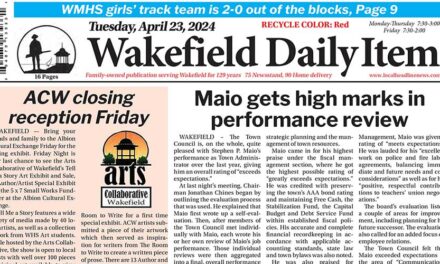Published in the June 28, 2016 edition.
By MARK SARDELLA
WAKEFIELD — The long-awaited report of the Lake Quannapowitt Committee has been completed and was delivered last night to the Board of Selectmen by Town Engineer and committee Chairman Michael Collins. Since being appointed in 2014 by the Board of Selectmen, the 13-member committee has spent more than two years studying and researching ways to improve the water quality of the Lake.
The take-away conclusion was that whatever is done to address the condition of the Lake will not be cheap and won’t happen overnight, although certain “in lake” approaches seem to promise quicker results.
Collins reviewed the committee’s report with the selectmen, beginning with some basic facts about the Lake. Quannapowitt has a surface area of 250 acres, Collins said, and holds nearly half a billion gallons of water. It has an average depth of six feet and a maximum depth of 11 feet.
Quannapowitt is an “impounded lake” with a control dam outlet at Lowell Street, Collin said, noting that because of the limited flow in and out, total water turnover occurs once every year to year and a half.
The land area around the Lake or “watershed” encompasses 450 acres with 300 acres feeding runoff into the Lake via drain outlets and 150 acres providing more direct runoff of storm water, according to the report.
Collins reviewed the committee’s two primary goals as stated in the report.
One goal was to find a way to bring the Lake into a condition where it would meet Massachusetts Water Quality standards for a swimmable/fishable body of water. Collins noted that the Lake is on the Department of Environmental Protection’s 2014 Impaired Waters List due to non-native aquatic plants, DDT, excess algae growth and turbidity.
The other goal, as stated in the committee’s report, was to eliminate blue-green algae (aka cyanobacteria) due to its toxicity and competition with healthy lake organisms. The cyanobacteria are responsible for the deep green color that the Lake assumes toward the end of some summer seasons.
Collins said that there was near unanimous committee agreement on the two goals but less consensus when it came to recommending solutions.
He said that for overall “in lake” approaches, the two methods that viewed most favorably were “aeration and circulation” and treating the Lake with aluminum sulfate to control phosphorus – a major nutrient source for cyanobacteria.
Collins mentioned “SolarBees” as one possible method of aerating and circulating the Lake water. He said that the committee had visited a lake on Cape Cod with a similar cyanobacteria problem to that seen in Wakefield where the SolarBees had been used with success. Solarbee aerators sit low on the water’s surface and pull up water from the lake bottom and circulate it out closer to the surface.
Collins said that with aluminum sulfate treatment the chemical binds with phosphorus and makes it unavailable in sufficient amounts to support cyanobacteria blooms.
Collins said that either of the two approaches could be implemented for a 10-year period at a cost less than $1 million.
So-called land side approaches include things that could be done around the watershed to improve the condition of the Lake. There was near unanimous agreement on a number of methods to limit the nutrients that enter the Lake from storm water runoff, including public education on limiting fertilizer use, various green infrastructure approaches, stepped up collection of leaves and brush, street sweeping, catch basin cleaning, storm water runoff treatment systems and shoreline riparian zones among others.
But Collins stressed the report’s conclusion that the land side approaches should be seen as supplemental. None of them, either individually or in combination, were seen by the committee as sufficient to reach the stated goals in the near term, if at all.
The committee’s report recommends that a consultant be hired to objectively review all available information and help the town decide if more investigation is needed to select a final action plan.
The committee also recommends continuing to monitor levels of cyanobacteria toxicity, dissolved oxygen levels and temperature conditions through the fall of 2016.
If aeration/circulation is selected to address the Lake’s issues, the committee recommends further investigation into available methods, configurations and manufacturers.
Another recommendation was that the town assign a town employee to advise property owners on things like use of fertilizer and other matters related to pervious areas.
Holding public forums to discuss Lake Quannapowitt conditions on possible solutions was another recommendation.
Board of Selectmen chairman Patrick Glynn thanked and commended the committee.
“It’s nice to know that there are those who care enough to go into this level of detail,” Glynn said, adding that he would support whatever measures were needed.
Selectman Ann Santos noted that they would need to convince the townspeople of the need to spend some money to fix the Lake’s problems.
Selectman Tony Longo said that he was leaning toward the SolarBee approach, but said, “Something needs to be done – sooner rather than later.”
Lake Quannapowitt Committee member Alison Simcox told the selectmen that the committee was split on the SolarBee aerators, claiming that the there was no support for their efficacy against cyanobacteria in peer-reviewed scientific literature.
But Collins said that the aerators have been used with success in hundreds of lakes in North America and that he had spoken to people who swore by them in a number of communities where they had been used.
Glynn told Collins that Town Administrator Stephen P. Maio would be in touch with him to discuss the next steps regarding the committee’s work.




